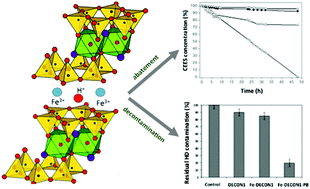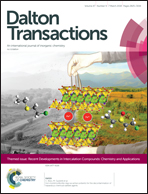Iron-montmorillonite clays as active sorbents for the decontamination of hazardous chemical warfare agents†
Abstract
A class of heterogeneous catalysts based on commercial bentonite from natural origin, containing at least 80 wt% of montmorillonite clay, was designed to transform selectively and under mild conditions toxic organosulfur and organophosphorus chemical warfare agents into non-noxious products with a reduced impact on health and environment. The bentonite from the natural origin was modified by introducing iron species and acid sites in the interlayer space, aiming to obtain a sorbent with strong catalytic oxidising and hydrolytic properties. The catalytic performance of these materials was evaluated in the oxidative abatement of (2-chloroethyl)ethyl sulfide (CEES), a simulant of sulfur mustard, in the presence of aqueous hydrogen peroxide as an oxidant. A new decontamination formulation was, moreover, proposed and obtained by mixing sodium perborate, as a solid oxidant, to iron-bentonite catalysts. Solid-phase decontamination tests, performed on a cotton textile support contaminated with organosulfide and organophosphonate simulant agents revealed the good activity of the solid formulation, especially in the in situ detoxification of blistering agents. Tests carried out on the real blistering warfare agent, sulfur mustard (HD agent), showed that, thanks to the co-presence of the iron-based clay together with the solid oxidant component, a good decontamination of the test surface from the real warfare agent could be achieved (80% contaminant degradation, under ambient conditions, in 24 h).

- This article is part of the themed collection: Recent Developments in Intercalation Compounds: Chemistry and Applications


 Please wait while we load your content...
Please wait while we load your content...